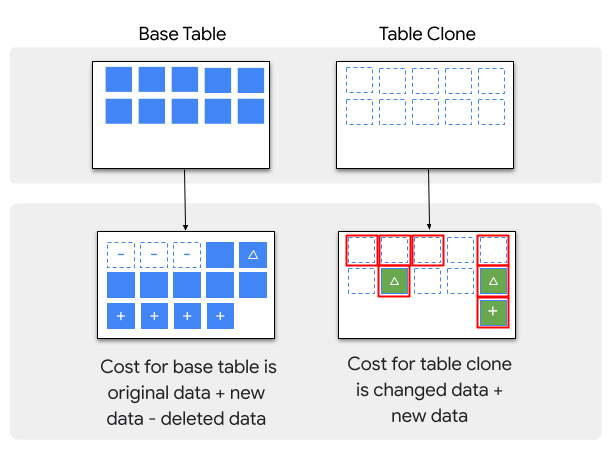Introduction to table clones
This document gives an overview of table clones in BigQuery. It is intended for users who are familiar with BigQuery and BigQuery tables.
A table clone is a lightweight, writable copy of another table (called the base table). You are only charged for storage of data in the table clone that differs from the base table, so initially there is no storage cost for a table clone. Other than the billing model for storage, and some additional metadata for the base table, a table clone is similar to a standard table—you can query it, make a copy of it, delete it, and so on.
Common use cases for table clones include the following:
- Creating copies of production tables that you can use for development and testing.
- Creating sandboxes for users to generate their own analytics and data manipulations, without physically copying all of the production data. Only the changed data is billed.
After you create a table clone, it is independent of the base table. Any changes made to the base table or table clone aren't reflected in the other.
If you need read-only, lightweight copies of your tables, consider using table snapshots.
Table clone metadata
A table clone has the same metadata as a standard table, plus the following:
- The project, dataset, and name of the table clone's base table.
- The time of the table clone operation. If time travel was used to create the table clone, then this is the time travel timestamp.
For more information, see INFORMATION_SCHEMA.TABLES.
Table clone operations
In general, you use table clones in the same way as you use standard tables, including the following operations:
- Querying
- Access control
- Getting metadata
- Partitioning and clustering
- Working with schemas
- Deleting
However, the creation of a table clone is different from the creation of a standard table. For more information, see Create table clones.
Storage costs
Storage costs apply for table clones, but BigQuery only charges for the data in a table clone that is not already charged to another table:
When a table clone is created, there is initially no storage cost for the table clone.
If data is added or changed in a table clone, then you are charged for the storage of the added or updated data.
If data is deleted in a table clone, then you are not charged for the storage of the deleted data.
If data is changed or deleted in the base table that also exists in a table clone, then you are charged for the table clone storage of the changed or deleted data. If there are multiple clones that contain the changed or deleted data, you are only charged for the storage used by the oldest clone.
If data is added to the base table after the table clone was created, then you aren't charged for storage of that data in the table clone, but you are charged for it in the base table,
The difference between base table and table clone storage charges is shown in the following image:

For more information, see BigQuery storage pricing.
Limitations
- You can clone a table between datasets in the same project, and between datasets in different projects. However, the destination dataset for the table clone must be in the same region, and under the same organization, as the table being cloned. For example, you cannot clone a table from an EU-based dataset into a US-based dataset.
- You can't create a clone of a table's data as it was further back than the duration of the time travel window for the table's dataset.
- You can't create a clone of a view or a materialized view.
- You can't create a clone of an external table.
- If you clone a table that has data in write-optimized storage (the streaming buffer for recently streamed rows), the data in the write-optimized storage is not included in the table clone.
- If you clone a table that has data in time travel, the data in time travel is not included in the table clone.
- Table clones can't be distinguished from standard tables in the Explorer pane. However, you can tell a table clone from a standard table by looking at the table details. Table clone details have a Base Table Info section that standard tables don't.
- You can't use a clone operation to append data to an existing table. For
example, you can't use the flag settings
--append_table=trueand--clone=truein the samebq cpcommand. To append data when duplicating a table, use a copy operation instead. - When you create a table clone, its name must adhere to the same naming rules as when you create a table.
- Table clone creation is subject to BigQuery limits on copy jobs.
- The time that BigQuery takes to create table clones might vary significantly across different runs because the underlying storage is managed dynamically.
Quotas and limits
Table clones are subject to the same quotas and limits as standard tables. For more information, see table quotas and limits. They also have table clone limits that apply.
